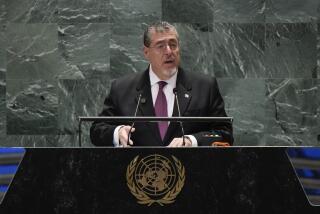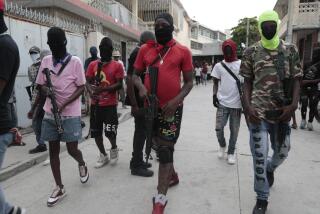U.S. to Train Costa Rica Rapid Reaction Force : Decaying Ties With Nicaragua Prompt Nation to End Era Without Army, Ask for American Aid
- Share via
WASHINGTON — Costa Rica, ending a 36-year era as the only Latin American nation without an army, has invited a team of U.S. servicemen to begin training a 750-man rapid reaction force next week, the Pentagon announced Monday.
An estimated 22 Special Forces trainers will arrive in Costa Rica about May 15 to lead a three-month basic training program for units of the Central American country’s existing civil guard, Maj. Fred Lash, a Pentagon spokesman, said. The guard is a national uniformed police force.
‘Program of Cooperation’
Costa Rican Security Minister Benjamin Piza confirmed the announcement and told United Press International in his country’s capital of San Jose that the training will be “part of an ongoing program of cooperation.”
“The training will be in general military skills, orienteering and patrolling,” Lash said. “The site will be in northwestern Costa Rica, at Murcielago, which is about 12 miles from the border with Nicaragua.”
Other Reagan Administration officials who asked not to be identified by name said that the U.S. and Costa Rican governments devised the training program because of the worsening relations between Nicaragua’s leftist regime and Costa Rica’s traditionally neutralist government.
“The Costa Ricans are increasingly nervous about the Sandinistas,” one senior official said. “This is the result of a long process of discussion.”
Longtime U.S. Urging
The Reagan Administration has been urging Costa Rica to give military training and equipment to units of the 9,000-man civil guard for more than two years, but the government of President Luis Alberto Monge finally approved the training for only a few specialized units.
A series of border clashes with Nicaraguan army units, political conflicts with the Sandinistas and the presence of as many as 2,000 anti-Sandinista rebels in northern Costa Rica impelled Monge to change course, the officials said.
Lash said that the Special Forces trainers, who are usually based in Panama, will not be conducting formal counterinsurgency training. But other officials said that one purpose of the program is to equip the Costa Ricans to fight leftist guerrillas, whom the State Department has accused Nicaragua of training.
Costa Rica dismantled its army in 1949 after elements of it participated in a civil war between the two main political parties. Since then, the country has been the most stable democracy in Central America, and many Costa Ricans say that the absence of any force able to carry out military coups has helped to keep it that way.
Since the Sandinista revolution of 1979, however, Monge’s government has slowly increased the civil guard’s equipment, largely with U.S. aid. American military aid to Costa Rica jumped from nothing in fiscal 1981 to $2 million in 1982, $4.6 million in 1983, $9.2 million in 1984 and $11 million this year.
Officials said the rapid reaction units being trained by the U.S. advisers will be equipped with their own vehicles, M-16 combat rifles, machine guns, mortars and anti-tank weapons. Although they will be equipped and trained as combat units, they will formally remain part of the civil guard, officials said.
They said that about 45 officers for the force have already been trained at the U.S.-run regional military training center in Honduras and will join the Americans in training enlisted men in two six-week courses.
The training still will leave Costa Rica’s security forces dwarfed by neighboring armies. Nicaragua has about 41,000 regular army troops and another 21,000 militiamen and has announced plans to expand its army still further.
Democrats in Congress have questioned the Administration’s plans for building up Costa Rica’s civil guard, and aides said that Rep. Michael D. Barnes (D-Md.) planned to ask Assistant Secretary of State Langhorne A. Motley about the issue at a hearing today.
More to Read
Sign up for Essential California
The most important California stories and recommendations in your inbox every morning.
You may occasionally receive promotional content from the Los Angeles Times.













